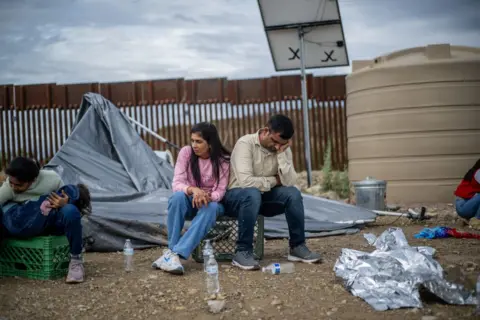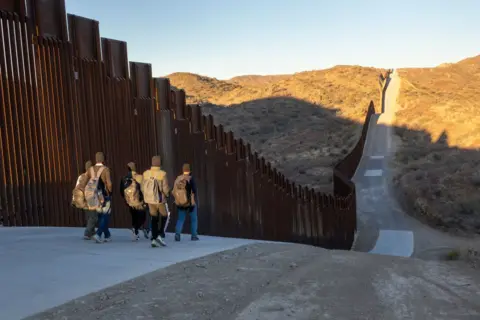Illegal and unseen: Nine surprising facts about Indians in the US
 Getty Images
Getty ImagesDonald Trump has made the mass deportation of undocumented foreign nationals a key policy, with the US said to have identified about 18,000 Indian nationals it believes entered illegally.
Last week Narendra Modi said India would take back its nationals who were in the US illegally, and also crack down on the "human trafficking ecosystem".
"These are children of very ordinary families, and they are lured by big dreams and promises," he said during his visit to Washington.
Now a new paper by Abby Budiman and Devesh Kapur from Johns Hopkins University has shed light on the numbers, demographics, entry methods, locations and trends relating to undocumented Indians over time.
Here are some of the more striking findings.
How many illegal Indians are in the US?
Unauthorised immigrants make up 3% of the US population and 22% of the foreign-born population.
The number of undocumented Indians among them is contested however, with estimates varying widely due to differing calculation methods.
Pew Research Center and Center for Migration Studies of New York (CMS) estimate some 700,000 people as of 2022, making them the third-largest group after Mexico and El Salvador.
In contrast, the Migration Policy Institute (MPI) puts the figure at 375,000, ranking India fifth among origin countries.
The official government data from the Department of Homeland Security (DHS) offers yet another picture, reporting 220,000 unauthorised Indians in 2022.
The vast differences in estimates highlight the uncertainty surrounding the true size of the undocumented Indian population, according to the study.
Yet numbers have dropped from their peak
Indian migrants make up only a small share of the overall unauthorised migrant population in the US.
If Pew and CMS estimates are accurate, nearly one in four Indian immigrants in the US is undocumented - an unlikely scenario given migration patterns, the study says. (Indian immigrants are one of the fastest-growing groups in the US, surging from 600,000 in 1990 to 3.2 million in 2022.)
The DHS estimated in 2022 that the undocumented Indian population in the US dropped 60% from its 2016 peak, falling from 560,000 to 220,000.
How did the number of undocumented Indians drop so steeply from 2016 to 2022? Mr Kapur says the data doesn't provide a clear answer, but plausible explanations could be that some obtained legal status while others returned, particularly due to COVID-related hardships.
However, this estimate doesn't reflect a 2023 surge in Indians at US borders, meaning the actual number could now be higher.
 Getty Images
Getty ImagesDespite rising border encounters, US government estimates show no clear increase in the overall undocumented Indian population from the US financial year (FY) 2020 to 2022, according to the study.
Encounters refer to instances where non-citizens are stopped by US authorities while attempting to cross the country's borders with Mexico or Canada.
Visa overstays by Indians have remained steady at 1.5% since 2016.
The number of Indian recipients of Deferred Action for Childhood Arrivals (Daca) has also declined from 2,600 in 2017 to 1,600 in 2024. The Daca programme protects migrants who came to the US as children.
To sum up: the undocumented Indian population grew both in numbers and as a share of all unauthorised migrants, rising from 0.8% in 1990 to 3.9% in 2015 before dropping to 2% in 2022.
A surge - and shifting migration routes
The US has two main land borders.
The southern border along the states of Arizona, California, New Mexico and Texas bordering Mexico sees the most migrant crossings. Then there's the US-Canada border spanning 11 states.
Before 2010, encounters involving Indians at the two borders were minimal, never exceeding 1,000.
Since 2010, nearly all encounters involving Indians occurred along the US-Mexico southern border.
In FY 2024, encounters of Indian nationals on the northern border surged to 36% of all Indian crossings, up from just 4% the previous year.
Canada had become a more accessible entry point for Indians, with shorter visitor visa processing times than the US.
Also, there was a surge in attempted border crossings from 2021 onwards, and the encounters at the Mexico border peaked in 2023.
"This is not specific to Indians. It is part of a larger surge of migrants trying to come into the US after Biden was elected. It is as if there was a high tide of migrants and Indians were a part of it," Mr Kapur told the BBC.
 Getty Images
Getty ImagesWhere are the illegal Indians staying?
The study finds that the states with the largest Indian immigrant populations -California (112,000), Texas (61,000), New Jersey (55,000), New York (43,000) and Illinois (31,000) - also have the highest numbers of unauthorised Indian immigrants.
Indians make up a significant share of the total unauthorised population in Ohio (16%), Michigan (14%), New Jersey (12%) and Pennsylvania (11%).
Meanwhile, states where more than 20% of Indian immigrants are unauthorised include Tennessee, Indiana, Georgia, Wisconsin and California.
"We expect this because it's easier to blend in and find work in an ethnic business - like a Gujarati working for a Gujarati-American or a Punjabi/Sikh in a similar setup," Mr Kapur said.
Who are the Indians seeking asylum?
The US immigration system allows people who are detained at the border who fear persecution in their home countries to undergo credible "fear screenings". Those who pass can seek asylum in court, leading to a rise in asylum applications alongside rising border apprehensions.
Administrative data doesn't reveal the exact demographics of Indian asylum seekers, but court records on spoken languages provide some insight.
Punjabi-speakers from India have dominated Indian asylum claims since 2001. After Punjabi, Indian asylum seekers spoke Hindi (14%), English (8%) and Gujarati (7%).
They have filed 66% of asylum cases from FY 2001–2022, suggesting Punjab and the neighbouring state of Haryana as key migrant sources.
Punjabi speakers from India also had the highest asylum approval rate (63%), followed by Hindi speakers (58%). In contrast, only a quarter of Gujarati speakers' cases were approved.
'Gaming the system' - why asylum claims are rising
US data collected by Organisation for Economic Co-operation and Development (OECD) shows Indian asylum requests in the US have skyrocketed.
The requests jumped tenfold in just two years, rising from about 5,000 in 2021 to over 51,000 in 2023.
While this spike is most dramatic in the US, similar trends are seen in Canada, the UK and Australia, where Indians are among the largest asylum-seeking groups, the study says.
Mr Kapur believes this is "largely a way to game the asylum system rather than an objective fear of persecution, as processing takes years".
Given the large number of Punjabi-speakers who seek asylum, it's unclear what has changed in the northern Indian state ruled by the Congress party (2017-22) and latterly the Aam Aadmi Party (2022–present) to drive this surge.
Under Trump's second presidency, asylum requests are set to plummet.
Within his first week, a key app for migrants was shut down and removed from app stores, cancelling nearly 300,000 pending appointments, including asylum cases already in progress.
 Getty Images
Getty ImagesWhat do asylum seekers tell us about India?
US data shows most Indian asylum seekers are Punjabi and Gujarati - groups from India's wealthier states, better able to afford high migration costs.
In contrast, Indian Muslims and marginalised communities and people from conflict zones like the regions affected by Maoist violence and Kashmir, rarely seek asylum, the study says.
So most Indian asylum seekers are economic migrants, not from the country's poorest or conflict-hit regions.
The arduous journey to the US - whether via Latin America or as "fake" students in Canada - costs 30-100 times India's per capita income, making it accessible only to those with assets to sell or pledge, the study says.
Not surprisingly, Punjab and Gujarat - top origin states for unauthorised Indians - are among India's wealthier regions, where land values far exceed returns from farming.
"Even illegality takes a lot of money to pursue," the study says.
What's fuelling illegal Indian migration?
While rising asylum claims may seem linked to "democratic backsliding" in India, correlation isn't causation, the authors say .
Punjab and Gujarat have long histories of emigration, with migrants heading not just to the US but also the UK, Canada and Australia.
Remittances - India received an estimated $120bn in 2023 - fuel aspirations for a better life, driven not by poverty but "relative deprivation", as families seek to match the success of others abroad, the study says.
A parallel industry of agents and brokers in India has cashed in on this demand.
The Indian government, says the study, "has looked the other way, likely because the issue of illegal migration is much more a burden for receiving than sending countries".
How many Indians have been deported?
Between 2009 and 2024, around 16,000 Indians were deported, according to India's ministry of external affairs.
These deportations averaged 750 per year under Obama, 1,550 under Trump's first term, and 900 under Biden.
Indian migrant removals spiked between FY 2023 and 2024, but the peak was in 2020 with nearly 2,300 deportations.
